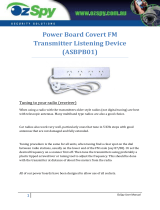
4.2.2 If the equipment surfaces are dirty, wash the ex-
ternal surfaces with mild soap and water using a
clean cloth. Be careful not to allow the electronic com-
ponents or connectors to get wet.
4.2.3 Preventive maintenance should be scheduled
regularly, i.e. monthly, quarterly, annually. The
interval of maintenance depends on equipment usage
and environment.
4.3 TROUBLESHOOTING
Check for proper operation of the tuner by per-
forming the procedure listed under the Pre-Operational
Check paragraph of this manual. If the tuner is not
operating properly, use the notes on the schematic
diagram and the attached troubleshooting chart to
localize the defective component.
5.
THEORY OF OPERATION
5.1 CIRCUIT FUNCTION
A fixed length antenna presents greatly varying
impedances when operating over a wide frequency
range. The tuner must enable the ant.enna to resonate by
compensating for the capacitive or inductive reactance
present. It must also match the resistive component of
the antenna to present a 50-ohm load to the radio out-
put. This antenna tuner is designed to perform both of
these functions automatically in less than 2.5 seconds
without making any preliminary adjustments or set-
tings.
5.2 CIRCUIT CONFIGURATIONS
"
Two different circuit configurations are used to
tune the antenna. To match antennas with capacitve
reactance, a pi configuration is used. The pi configura-
tion consists of parallel capacitance, followed by series
inductance, followed by parallel capacitance. To match
antennas with inductive reactance, an L configuration is
used. The L configuration consists of series inductance
followed by parallel capacitance.
5.3
CIRCUIT DESCRIPTIONS
5.3.1
Tuning Elements
5.3.1.1 The tuning elements of the antenna tuner con-
sist of inductive and capacitive components
that are switched into the rf circuit by a series of reed
relays. The tuning elements are selected by the tuner
microcomputer, which enables the transistor driver cir-
cuits that activate the relays. The tuning element net-
work consists of parallel capacitance, followed by series
inductance, followed by parallel capacitance. In addi-
tion, there is an output inductance of 26.25 micro-
henries that can be selected by the microcomputer and a
4
.J
fixed output capacitance of 50 picofarads.
5.3.1.2 There are five steps of switchable input
capacitance arranged in a binary order, that is,..
the value of a switchable capacitance is half the value of
the next largest switchable capacitance. The values of
switchable input capacitance are 2000, 1000, 500, 250,
and 120 picofarads. The values of switchable output
capacitance for Models T1961A and T1959A are 400,
200, 100, 50, and 27 picofarads. The values of switch-
able output capacitance for Model TI962A are 50 and
100picofarads.
5.3.1.3 There are ten steps of switchable inductance
arranged in binary order. The values of switch-
able inductance are: .08, .15, .29, .55, 1.05, 1.99, 3.8,
7.24, 13.78, and 26.25 microhenries.
5.3.2 Phase Detector
-y
The phase detector circuit consists primarily of
TI, Ul, U2, U3, and U6D. This circuit compares the
phase of the rf voltage to the phase of the rf current and
generates either a logic high or logic low at U6-14. When
the antenna and the tuner represent an inductive load to
the rf output of the radio, the rf current lags the rf
voltage, resulting in a logic high (5 V) at U6-14. When
the antenna and tuner represent a capacitive load to the
rf output of the radio, the rf current leads the rf voltage,
resulting in a logic low (0 V) at U6-14.
5.3.3 VSWR Detector
The VSWR detector consists primarily of T2 and
U6C. A voltage proportional to the forward power of
the transmitter output is developed at U6-1O. A voltage
proportional to the reverse power of the transmitter out-
put is developed at U6-11. If both U5B and U5C are not
activated by the microcomputer, U6-13 drops from
5 volts to 0 volts when a VSWR of 4:1 is achieved. If
U5B is activated, the 5 to 0 volt transition takes place
when a VSWR of 2:1 is acheived. If U5C is activated,
the 5 to 0 volt transition takes place when a VSWR of
1.5:1 is acheived.
5.3.4 Channel Change Circuit
The channel change circuit consists primarily of
transistors Q28-Q33 and inverter U7C. When a radio
channel change takes place, the channel change circuit
applies a negative going, 0.5 second pulse to the
POWER ACK and TUNED INPUT ports of the micro-
computer. This pulse prohibits the microcomputer from
beginning a tuning sequence until radio channel selec-
tion is complete. One-half second after the channel
change is complete, there is a transition from 5 volts to
0 volts at U7-6. The transition enables the microcom-~.
puter to begin its tuning' sequence. The channel change'
circuit responds only to channel selections made with
A
























